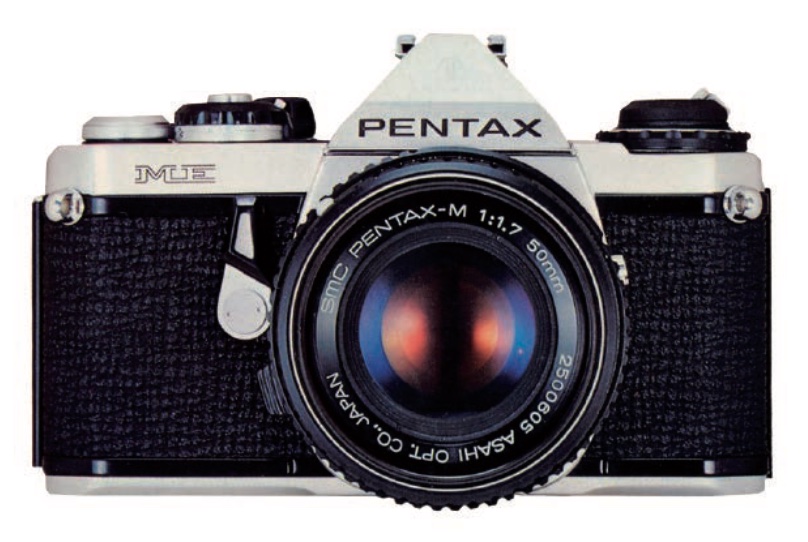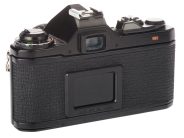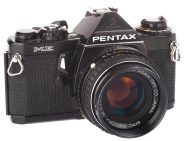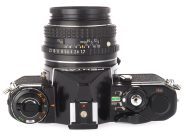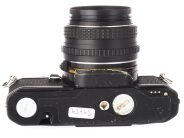Asahi Pentax ME
35mm MF film SLR camera • Discontinued
- Announced:
- · December 1976
- Production status:
- ● Discontinued
- Country of design:
- · Japan
- System:
- · Pentax K (1975)
Specification
| Format: | |
| 35mm full frame | |
Film type: | 135 cartridge-loaded film |
| Pentax K [45.5mm] | |
| Shutter: | |
Type: | Focal-plane |
Model: | Electronically controlled |
Speeds: | 8 - 1/1000 + B |
| Exposure: | |
Exposure metering: | Through-the-lens (TTL), open-aperture |
Exposure modes: | Aperture-priority Auto |
| Physical characteristics: | |
Weight: | 460g |
Dimensions: | 131x82.5x49.5mm |
Manufacturer description #1
There may be more major innovations in this camera than in any 35mm SLR you've ever seen.
The Pentax ME comes from a long tradition of camera innovation.
At Pentax, we practically invented the look of today's 35mm SLR. And we've sold more of them than anyone else in the world.
We were the first to mass-produce 35mm SLRs combining the pentaprism and instant-return mirror. We were the first to use TTL (through-the-lens) light metering. We introduced the first Super-Multi-Coating for 35mm lenses. And we were the first to offer automatic electronic exposure in a 35mm SLR.
At Pentax, we believe our photo engineers have made more major advances in 35mm SLRs than any company in the world.
And we're especially proud of the Pentax ME.
The ME is the smallest, lightest, most compact 35mm SLR in the world. But we didn't achieve this by resorting to plastic materials, like some other leading cameras. The Pentax ME has solid, all-metal cover plates, so it can take a lot of abuse.
Total automation
To free you from as many operational procedures as possible, we've designed into the ME an exposure system so advanced, there is no need to include a conventional shutter speed dial.
Instead, you'll find our unique "shutter control selector." When it's set to "Auto", the ME goes into action as a totally automated, aperture-priority camera. You pick the f/stop. An internal computer picks the precise shutter speed and displays it in the viewfinder.
If you prefer a different shutter speed, simply turn the aperture ring until the speed you desire is displayed. You can do this in less time than it just took you to read about it. And you can do it without taking the camera from your eye.
Once the Pentax ME has decided on an exposure setting for you, you can still override that decision by up to ±2 EVs. So even if you have a special effect in mind, or a peculiar lighting situation to deal with, you still have superb manual control.
Unlike shutter-priority cameras, the aperture-priority ME gives you full control over your depth-of-field. And even with a bellows or other components attached, the ME still functions automatically.
So even though the PentaxNE is fully-automatic, it provides as much manual control and creative flexibility as you're ever likely to need.
The Pentax-Seiko shutter
The Pentax ME features a focal plane shutter jointly invented by Seiko and Pentax. It has received considerable recognition for its accuracy, minimal noise and vibration, and durability. This stepless, automatic shutter helps make the outstanding automatic exposure accuracy of the ME possible.
The panoramic viewfinder
We've taken the concept of TTL metering to its logical conclusion in the ME. The first thing you'll notice when you look into the viewfinder is just how big and bright the image is. The next thing you'll observe is a line of 16 small, solid-state, red LEDs. 14 of these indicate the shutter speed selected by the camera. And two of them indicate whether you're under- or over-exposed.
The light meter. A Pentax first.
Of course, no exposure can be more accurate than the light-sensing capability of the camera. And the light sensors in the ME constitute a major design breakthrough, invented by Pentax in conjunction with Nippon Electric, and first used by Pentax.
They're called Gallium Arsenide Phosphide Photo Diodes (GPDs) and they're a significant improvement over any other light sensor. Even in radical light shifts they react 1,000 times faster than CdS cells. And unlike silicon blue cells, they are immune to infrared radiation. GPDs are extremely stingy with battery power and they can withstand almost any temperature change you'd encounter, without adverse effect. GPDs are definitely the wave of the future. Eventually, you'll probably see them in many SLRs. But we don't mind. We're used to being copied.
Long-lasting power
The two tiny 1.5 volt silver oxide cells will last an unbelievably long time, thanks to the electronic efficiency of the Pentax ME. The camera uses only 3V compared to the 6V required by most other LED readout cameras. Battery life in the ME is expected to last for over 10,000 exposures, even though the batteries power both the shutter and the light meter. You could shoot a 36-exposure roll daily for a year, without battery failure.
When battery power is low, our unique Battery Check Circuit causes the LED visible in the viewfinder to flash on and off, telling you it's time to change batteries. And even when the batteries are dead, you can still keep shooting manually at 1/100 sec. Some other leading 35mm automatics stop operating completely when the batteries die.
Precision lenses
A lot of SLRs have been made smaller lately, but unfortunately, their lenses haven't. Pentax, however, decided to design 19 new ultra-thin, ultra-light M-series lenses for use on the ME. Of course, our regular Pentax lenses also fit the ME. So there are over 40 interchangeable Pentax lenses available to cover any situation, from 2,000mm telephoto to 17mm fisheye. All have Pentax bayonet mounts, which are quickly becoming the standard of the industry. And all have Pentax Super-Multi-Coating, a process which we invented and perfected.
Action shots with the Winder ME
The Pentax ME accepts an automatic winder, the Winder ME, for smooth, quick, automatic film advance. You can attach it in seconds. It fires off exposures at up to 1.5 fps, or if you prefer, one shot at a time.
Dial Data ME back
The back cover of the ME is interchangeable with the compact, easy-to-use Dial Data ME back. With it, you can instantly convert your ME into a data camera, recording the date, or, if you prefer, technical data such as aperture, shutter speed, and frame number.
At Pentax, we've made more major breakthroughs in 35mm SLR design and invention than any other company in the business. In the Pentax ME, we've continued the tradition. Someday, the advances we've incorporated into the ME may be the standard for all SLRs. But for now, they're only available with the original. The Pentax ME.
Manufacturer description #2
TYPE: 35mm full-frame SLR camera with aperture preferred automatic exposure electronic focal-plane shutter and open-aperture center-weighted Through-The-Lens metering
LENS MOUNT: Pentax K bayonet
SHUTTER: Seiko MFC vertical-run metal focal-plane shutter; automatic exposure electronically controlled between B and 1/1000 sec.; manual mechanical speed of 1/100 sec. plus B; provided with shutter button lock and "Cocked" indicator
FLASH SYNCHRONIZATION: X socket on front of camera body, plus X-contact hot/cold accessory shoe; X flash synchronizing at 1/100 sec.
SELF-TIMER: Delays shutter release 4-10 seconds
VIEWFINDER: Silver-coated pentaprism finder; split-image microprism focusing screen; 92% of picture-taking area visible and 0.97x magnification (with 50mm lens at infinity); -0.5 diopter eyepiece. LED dots inside viewfinder indicate automatically selected shutter speeds, plus over and under exposure warning. Correction lens adaptor M, Magnifier M and Refconverter M fit the viewfinder frame
MIRROR AND DIAPHRAGM: Instant-return mirror and automatic diaphragm
FILM WIND AND REWIND: Single-stroke rapid wind lever, plastic-tipped for winding comfort. 135° throw with stand-off angle of 30°. Rapid rewind crank for speedy film rewind
FILM LOADING: New magic-needle quick/sure loading
AUTOMATIC WINDER: ME camera body accepts the new 1.5-frames-per-second automatic film winder, for consecutive or single frame exposure operation
EXPOSURE COUNTER: Automatic reset type
EXPOSURE METER: Open-aperture, center-weighted Through-The-Lens meter, with GPD cells for fast light response, with LED exposure read-out; rapid wind lever and shutter release button acting as meter switch. Exposure range: EV 1-19 (ASA 100, f/1.4). Film speed range: ASA 12-1600. Exposure compensation dial: 1/4x, 1/2x, 1x, 2x, 4x
BATTERY: Two 1.5V silver oxide batteries (G13); LED's double as battery check lamp
BACK COVER: Standard back with memo holder, interchangeable with Dial Data ME for data recording on film
Manufacturer description #3
ME and MX - the world's smallest, lightest, most compact / easy-to-use, full-featured 35mm SLR cameras!
Rugged dependability, innovative technology, ease of use and featured for the professional. All packed into the smallest, lightest SLR cameras in the world!
Advanced Electronic Technology
Solid-state, accurate and reliable electronics are superbly blended with famous Pentax optical quality. IC circuitry and a mini-computer (in the ME) have been integrated in an all new, amazingly compact, camera body.
New Metering Breakthrough
Newly developed GPD's (Gallium Arsenide Phosphorous Diodes) provide exposure accuracy and speed never before attainable. They are 1,000 times faster than conventional CdS cells, and respond instantly to any light change without any 'memory lag'. And, unlike silicon cells, GPD's are insensitive to temperature extremes and infrared.
New Shutter Advances
The fully automatic ME utilizes an improved, smaller version of the Seiko stepless, electronic shutter. The 11 blade, all metal, focal plane shutter is extremely quiet and vibration free.
The new, compact focal plane shutter in the MX has been matched to a new mirror dampening system that virtually eliminates all vibration during an exposure. This new system enables sharp, pictures even in critical close-up photography.
Brilliant Viewfinders
Both the ME and MX have new silvered viewfinders that offer a large, extremely bright image that's easy to focus accurately on. Exposure indications are through LED's which have a new stabilizer and hold circuit that eliminates the common flicker and jumping between the neighboring LED's. The combination split-image and microprism focusing system enables easy, fast pinpoint focusing under any light condition.
A System to Grow With
Auto winders are offered at an easily affordable price for both the ME and the MX. ln addition, a motor drive unit is available for the MX. These will greatly enhance your picture taking capabilities and let both the amateur and the professional concentrate on their picture taking rather than on the operation of the camera. Both the winders and the motor drive unit attach directly to the cameras and are so compact that together with the camera they are equal to most standard cameras in size.
Additionally, there is a whole new line of Ultra-compact lenses and an extensive range of accessories to fulfill every photographer's needs ... and some to even create some new endeavors.
Similar cameras (77)
| Model | Shutter | Metering | Modes | Year |
|---|---|---|---|---|
| Almaz-103 akaАлмаз-103 |
M, 1/1000 | -- | M | 1980 ● |
| Alpa Si 3000 | E, 1/1000 | TTL · OA | AM | ● |
| Chinon CA-4 akaAgfa Selectronic 2 akaRevueflex ACX |
E, 1/1000 | TTL · OA | A | 1980 ● |
| Chinon CA-4s akaRevue AX3 |
E, 1/1000 | TTL · OA | A | ● |
| Chinon CE-4 akaAgfa Selectronic 3 akaRevueflex AC2 |
E, 1/1000 | TTL · OA | AM | 1979 ● |
| Chinon CE-4s akaRevue AC3 akaRevue AC3s |
E, 1/2000 | TTL · OA | AM | 1982 ● |
| Chinon CE-5 | E, 1/2000 | TTL · OA | AM | 1982 ● |
| Chinon CG-5 | E, 1/1000 | TTL · OA | AM | 1982 ● |
| Chinon CM-4 akaAgfa Selectronic 1 akaRevueflex SC2 |
M, 1/1000 | TTL · OA | M | 1980 ● |
| Chinon CM-4s akaRevue SC3 akaVivitar XV-11 |
M, 1/1000 | TTL · OA | M | ● |
| Chinon CM-5 akaVivitar XV-5 |
M, 1/1000 | TTL · OA | M | 1982 ● |
| Chinon CM-7 | M, 1/2000 | TTL · OA | M | 1987 ● |
| Chinon CP-5 Twin Program akaRevue AC4 SP |
E, 1/1000 | TTL · OA | PAM | 1983 ● |
| Chinon CP-5s Twin Program | E, 1/1000 | TTL · OA | PAM | 1984 ● |
| Chinon CP-6 Spot Twin Program | E, 1/1000 | TTL · OA | PAM | 1985 ● |
| Chinon CP-7m Multi-Program akaRevue AC5 |
E, 1/2000 | TTL · OA | PAM | 1986 ● |
| Chinon CP-X Program | E, 1/1000 | TTL · OA | PAM | 1985 ● |
| Chinon DP-5 Double Program | E, 1/1000 | TTL · OA | PAM | ● |
| Chinon DSL | M, 1/1000 | TTL · OA | M | ● |
| Cimko LS-1 akaLindenblatt KL-2 |
E, 1/1000 | TTL · OA | AM | 1982 ● |
| Cosina C1 akaPhoenix P1 akaVivitar V4000 akaVoigtlander VSL 40 |
M, 1/2000 | TTL · OA | M | ● |
| Cosina C1s akaRevue SC5 akaVivitar V4000s |
M, 1/2000 | TTL · OA | M | ● |
| Cosina C2 akaRevue SC5 auto |
E, 1/1000 | TTL · OA | AM | ● |
| Cosina CS-1 akaPetri MF-3 akaPorst compact reflex OS |
E, 1/1000 | TTL · OA | M | 1978 ● |
| Cosina CS-2 akaPetri MF-4 akaPorst compact reflex OV |
E, 1/1000 | TTL · OA | A | 1978 ● |
| Cosina CS-3 akaPorst compact reflex OC akaPorst compact reflex OC-N |
E, 1/1000 | TTL · OA | AM | 1978 ● |
| Cosina CT-1 akaPetri MF-101 akaPorst compact reflex OE akaVivitar XV-1 akaVivitar XV-10 |
M, 1/1000 | TTL · OA | M | 1979 ● |
| Cosina CT-10 akaPetri GX-2 |
E, 1/1000 | TTL · OA | A | 1981 ● |
| Cosina CT-1A akaPetri GX-1 akaPetri MF-101A akaSoligor SC-1 |
M, 1/1000 | TTL · OA | M | 1980 ● |
| Cosina CT-2 akaPetri MF-102 akaVivitar XV-2 akaVivitar XV-20 |
E, 1/1000 | TTL · OA | A | 1980 ● |
| Cosina CT-20 akaPetri GX-3 |
E, 1/1000 | TTL · OA | A | 1981 ● |
| Cosina CT-3 akaPetri MF-103 |
E, 1/1000 | TTL · OA | A | 1981 ● |
| Cosina CT-4 akaPetri MF-104 akaPorst compact reflex AM akaVivitar XV-3 |
E, 1/1000 | TTL · OA | AM | 1981 ● |
| Cosina CT1 Super akaExakta HS-2 akaMiranda MS-1 Super akaPetri GX-1 Super akaRevue SC4 akaRevue SC4-m |
M, 1/2000 | TTL · OA | M | 1984 ● |
| Cosina CT1EX akaExakta HS-10 akaMiranda MS-1N akaVivitar V2000 akaVivitar V335 |
M, 1/2000 | TTL · OA | M | 1988 ● |
| Cosina CT1G akaExakta HS-1 akaMiranda MS-1 akaPetri GX-1 |
M, 1/1000 | TTL · OA | M | 1984 ● |
| Cosina CT9 akaExakta HS-40 akaMiranda MS-2 Super akaMiranda MS-3 akaPetri GX-5 akaRevue AT-m |
E, 1/1000 | TTL · OA | AM | 1986 ● |
| Cosina E1 Solar akaRevue Solar 100 |
M, 1/2000 | TTL · OA | M | 1994 ● |
| Cosina PM-1 | M, 1/1000 | TTL · OA | M | ● |
| Cosina [Computer] CT7 akaExakta HS-3 akaPetri GX-4 |
E, 1/1000 | TTL · OA | AM | 1981 ● |
| Ricoh KR-10 akaRicoh CR-10 akaRicoh XR-1000S |
E, 1/1000 | TTL · OA | AM | 1980 ● |
| Ricoh KR-10SE | E, 1/1000 | TTL · OA | AM | 1980 ● |
| Ricoh KR-5SV | M, 1/2000 | TTL · OA | M | 2000 ● |
| Ricoh XR Solar | M, 1/2000 | TTL · OA | M | 1994 ● |
| Ricoh XR-1 | M, 1/1000 | TTL · OA | M | 1977 ● |
| Ricoh XR-10 akaRicoh KR-10x |
E, 1/1000 | TTL · OA | AM | 1986 ● |
| Ricoh XR-10M akaRicoh KR-10M akaRicoh XR-X 2000 |
E, 1/2000 | TTL · OA | AM | 1990 ● |
| Ricoh XR-10P akaRicoh XR-X 3P |
E, 1/2000 | TTL · OA | PASM | 1995 ● |
| Ricoh XR-10PF akaRicoh XR-X 3PF |
E, 1/3000 | TTL · OA | PASM | 1995 ● |
| Ricoh XR-1S | M, 1/1000 | TTL · OA | M | 1979 ● |
| Ricoh XR-2 | E, 1/1000 | TTL · OA | AM | 1977 ● |
| Ricoh XR-2000 akaRicoh KR-10 Super |
E, 1/1000 | TTL · OA | AM | 1982 ● |
| Ricoh XR-20SP Program akaRicoh KR-30SP Program |
E, 1/2000 | TTL · OA | PASM | 1985 ● |
| Ricoh XR-2S | E, 1/1000 | TTL · OA | AM | 1979 ● |
| Ricoh XR-7M | E, 1/1000 | TTL · OA | AM | 1989 ● |
| Ricoh XR-7M II | E, 1/2000 | TTL · OA | AM | 1993 ● |
| Ricoh XR-8 akaRicoh KR-5 Super II |
M, 1/2000 | TTL · OA | M | 1993 ● |
| Ricoh XR-8 Super akaRicoh KR-5 III |
M, 1/2000 | TTL · OA | M | 1994 ● |
| Ricoh XR-F | E, 1/1000 | TTL · OA | AM | 1983 ● |
| Ricoh XR-P Multi-Program | E, 1/2000 | TTL · OA | PASM | 1984 ● |
| Ricoh XR-S | E, 1/1000 | TTL · OA | AM | 1981 ● |
| Ricoh XR-X 3000 | E, 1/2000 | TTL · OA | AM | 1994 ● |
| Ricoh XR-X Multi-Program akaRicoh XR-M Multi-Program |
E, 1/2000 | TTL · OA | PASM | 1987 ● |
| Ricoh XR5 akaRicoh CR-5 akaRicoh KR-5 Super |
M, 1/1000 | TTL · OA | M | 1980 ● |
| Ricoh XR500 akaRicoh KR-5 |
M, 1/500 | TTL · OA | M | 1978 ● |
| Ricoh XR500 auto | E, 1/1000 | TTL · OA | AM | 1982 ● |
| Ricoh XR6 | E, 1/1000 | TTL · OA | AM | 1981 ● |
| Ricoh XR7 | E, 1/1000 | TTL · OA | AM | 1982 ● |
| Topcon RM 300 akaEdixa CX 5 akaExakta KE 4 akaExakta KE 5 |
M, 1/1000 | TTL · OA | M | 1978 ● |
| Vivitar V6000 | E, 1/1000 | TTL · OA | AM | 1989 ● |
| Zenit-122K akaЗенит-122К |
M, 1/500 | TTL · WA | M | 1990 ● |
| Zenit-14 akaЗенит-14 |
E, 1/1000 | TTL · OA | M | 1987 ● |
| Zenit-212k | M, 1/500 | TTL · WA | M | 1995 ● |
| Zenit-AM / AM2 / AM3 akaЗенит-АМ / АМ2 / АМ3 |
E, 1/1000 | TTL · OA | A | 1989 ● |
| Zenit-APK akaЗенит-АПК |
E, 1/2000 | TTL · OA | AM | 1992 ● |
| Zenit-Avtomat akaЗенит-Автомат |
E, 1/1000 | TTL · OA | A | 1985 ● |
| Zenit-km | E, 1/2000 | TTL · OA | AM | 2001 ● |
